
Caste system in modern india
English word caste is derived from the Portuguese word ‘casta’ which means a particular race.So, caste refer to the individual occupation and not to refer any derogatory person as commonly precieved
If You haven’t read my earlier post, then please read Part-1 , Part-2 , part-3 ,part-4 and part-5 on caste system before you read this post
Classical Indian Caste System:
Although importance were given to caste still during most of the Indian history, caste system was not absolute. For ex, powerful Gupta Dynasty, which ruled india betweeen 320-550 CE, were from the Businessman (Vaishyas) caste rather than the Warriors(Kshatriya) caste. Similarly, many other powerful rulers were also from lower castes, such as Nayaks(vaishyas) of madurai(r. 1559-1739).
From the 12th century, Muslims started dominated india. Muslim kings annihilated the power of Brahmins-Hinduism priestly caste. Kshatriyas(warriors)- The traditional Hindu rulers ceased to exist only in central and north India. The Shudra and Vaishya castes were virtually combined together.
Upper caste people were most affected from the rule of muslims rulers' but anti-Muslim feeling in rural backward areas was the reckoning force behind the strengthened caste system. Hindu villagers rejected muslim rulers ideology and reconfirmed their identity through their caste.
However, the six centuries of Islamic rule(c. 1150-1750) eveolved the caste system evolved. For instance, some Brahmins started farming for their daily income, since the brahmins were not gifted alms and food by Muslim kings.
The Caste System during medieval age:
The three key domains dominated by caste were meals, marriage and right of conducting religious worship. Marriage outside caste was forbidden strictly due to which sometimes many people married within their own jati(sub-caste).
Anyone Can take food from a Brahmin hand, but a Brahmin would become sinful if he/she accepts food from non-brahmins. To say more, if any untouchable drew water from a well, he/she has polluted the well water and surrounding areas and nobody should use that water anymore.
In terms of worship, only the priestly class- Brahmins were allowed to conduct religious services, yagnas and rituals. This also included celebrations of festivals and special occasions like marriages and funerals.
The and Vaisya and Kshatriya castes can offer worship to god, but Shudras(servants) were prohibited to offer anything like flowers, milk etc to idols of the gods.
Untouchables were completely barred from entering temples, and many places, untouchables were even denied to set foot anywhere near temple surroundings.
If the shadow of an untouchables falls on a Brahmin, he/she becomes contaminated, so untouchables should maintains a distance from the brahmin.
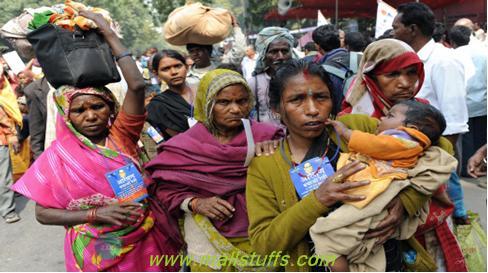
Dalits or Untouchables
Thousands of Castes:
According to vedas, there are four primary castes, but today we find thousands of castes, sub-castes (jati) and furher divisions (Communities) within Indian society. Sub-castejati are derived on the basis of both occupation as well as social status.
Some of the sub-caste include groups such as the Bhumihar(landowners), Kayastha(scribes) or, and Rajput(Kshatriya of northern states especially rajasthan)
Some caste were based from specific occupations like the Garudi(snake charmers) or Sonjhari(Gold refiners).
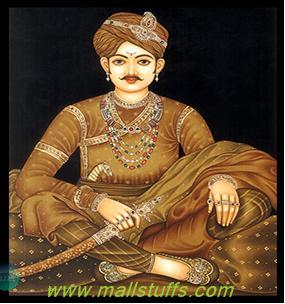
Rajput king
The Untouchables:
People who violated the above caste rules would be barred from the kingdom and would be treated as untouchables." Untouchables were not from lower caste but they and their immediate family members were strictly kept outside the caste system due to their extreme impure deeds.
Untouchables were believed to be so impure that even their mere presence would contaminate the other caste person. In extreme cases, other caste-person have to bathe and wash off his clothes immediately.
As a result, untouchables did work that other finds very impure like scavenging animals waste or carcasses, cleaning garbage. leather-work, killing mice and similar pests. on their death, cremation was not done and their body were left open as a food to eagles and vultures..
Caste system in british raj:
Post 1757, When British came to power in India, they exploited caste system as a tool for maintaining their rule over india.
First, British made brahmins their ally by restoring some of their privileges revoked by the Muslim rulers. However, britsh found many caste based customs, specially the ones concerning the lower castes, discriminatory and were outlawed.
During the 1930s and 40s when the anti-british activities were high, the British government made laws to save the untouchables and similar low caste people by grouping them under the special category called "Scheduled castes".
This move was well supported by Indian society under the guidance mahatama gandhi and other freedom fighers where they demanded complete annihilation of untouchability. As a result, In 1928, untouchables or Dalits ("the crushed ones") were allowed to worship in temples with upper caste members. Mohandas Gandhi supported revival of the Dalits, by referring dalits as harijan(Children of God).
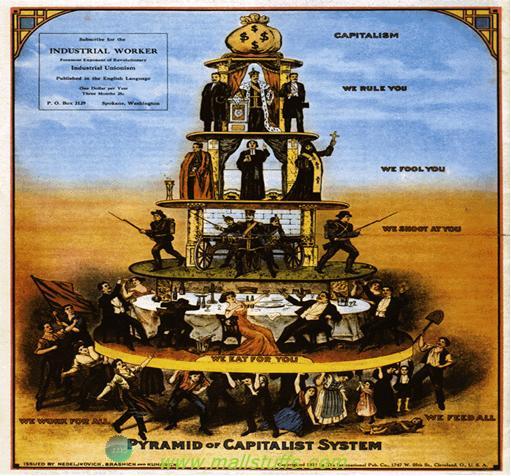
Generalized Caste system across the world
Caste Relations in Independent India:
The India became independent on August 15, 1947. First government of india immediately enacted new laws to give special treatment to both the untouchables and forters(adivasis) by grouping them under the categgory "Scheduled castes" and "Scheduled tribes" respectively. one of the law enacted was quota systems in government and educational institutions
Post independence, all citizens including dalits were guaranteed equal status and basic fundamental rights. Traditional untouchability practice was declared officially as a serious crime, with severe punishament. Steps were taken to identify and save the dalits from ill treatment and exploitation. Quota system helped them in competing with higher castes peoples in areas of education and employment As a result, Today, all around india, many leadership and high authority positions in every professions are occupied by the lower caste individuals. Many low caste people are still left behind and a lot of improvements is still required, but the Indian government has craeted so many provisions for the lower castes that some high castes have started complaining of being discriminated and kept at a disadvantage. By safeguarding the lower castes basic rights and giving them enough opportunities for fair competition, the Indian government were successful in averting a major civil disaster for the newly independent country such as mass religious conversions or civil war between higher caste and lower caste peoples. Additionally, manyconstitutional reforms were established to face the present caste system. These are:
1) Modern Education:
Education based on domestic values and secular principles, played a vital role in reducing the significance of Caste System in Indian Society. On one side, it gives obeyance to the democratic values like liberty,equality and fraternity and on the other side, expands scientific look like observation and reason.
Due to democratic modern education, educated class of people deviate from the vedic study of inherited inequality, divine origin of caste, hereditary occupation and karma as the direct consequence of Caste System. Modern education also encourages inter-caste marriage, love marraiges, among the educated young citizens.
2) Industrialisation:
Scientific revolution has intensified the process of industrialisation all around India. As a result, the old tradition of caste is no longer in use. Now, members of all caste can seek employment on the basic of their talent and education. People of diffrent faiths and caste works in the same industries and factories together.
Thus, there is no chance of a individual respecting the tradtional restrictions predetermined by Caste System. For example, an untouchable cannot avoid his shadow to be casted on the brahmin working along his side. Similarly in Government offices and private factories, lower caste people occupy higher posts and higher caste people works as their subordinate.
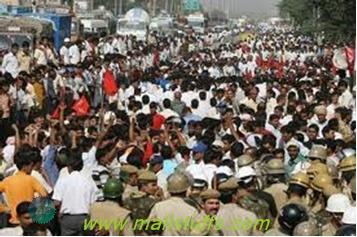
Workers working in fatory
3) Urbanisation:
Urbanisation can be called as side effect of industrialisation. Since people of diffrent religion,caste and languages lives in the same city, it has become increasingly difficult to follow traditional caste restrictions. Morever, in a civilised city, one individual is not bothered or cannot determine about the caste of another individual, ideas of getting contaminated by touch of shadow has gone from the minds of the urban people.
4) Rapid advancement in Communication and Transportation :
To some extent, Rapid means of communication and transportation have extremely disintegration the Caste System. Due to rapid industrial development, there is increasing use of different types of modern transportation like trains, buses, trams etc and So, now it is impossible to follow caste rules regarding social intercourse, food drinks etc while traveling.
As a law abiding citizens,the people of all castes behave equally to his fellow commuters while traveling in buses or trains.
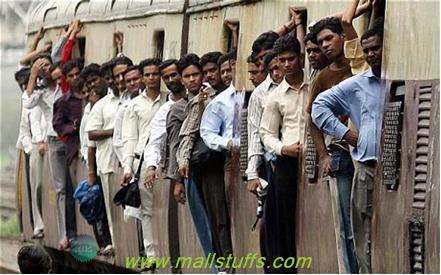
People of all caste travelling together
5) Social Reform Movement:
social reforms movemen main aim is the removal of various social problems created by Caste System in indian society.Swami Vivekananda, Raja Rammohan Ray,Swami Vinova Vave, Swami Dayananda Saraswati, Ramkrishna Paramahansa and others were the main members of this movement and they tried their best to remove untouchability and Caste System. Many religious institutions like Arya Samaj,Brahman Samaj and Ramakrishna Mission played a vital role in this reform movement.
6)Political Movement:
politicians regularly exploit Caste System in their speech to attract voters. Mahatma gandhi advocated the abolishment the traditional Caste System. He regularly raised his voice against the Caste System and treated untouchability as crime against God and humans.”
This political movement main aim was to annihiliate all caste based discriminatory traditions and practices.
7) Religious Movement:
One of the major reason for the decline of caste systems was the various religious. Among these important ones were Brahma Samaj(of Raja Rammohan Roy), Ramakrishna Mission(of Ramakrishan Paramahansa), Arya Samaj(of Swamy Dayananda Saraswati). Their movement single aim was to eradicate or remove feeling of superiority-inferiority and untouchability in the indian society.
8) Introduction of Inter-caste Marriage:
In the past, there were many restrictions in marriage such as caste members should marry within their own caste, Inter caste marriage strictly forbidden etc. As per the new enacted Hindu Marriage Act (1955),higher caste individual can marry with individual of lower caste. Therefore today, members of all caste marry according to their own free will.
9) Increase in the significance of Wealth:
Today, wealth and not birth is considered as the basis of social prestige and honour. Today, Caste no longer decides the social status, since a rich Shudra is more revered than a poor Brahmin. People choose their occupations based on income or interest rather than anything else.
10) Inter-communal Marriage:
This is also responsible to affect Caste System to some extent. The marital relationship between two religion(like Hindus and Muslim) is called inter communal marriage. This kind of marriage is strictly prohibited not only in Indian Society but also in foreign societies.
But now a days, globalisation has given rise to inter communal marriages. Hence, you find many Indians marrying outside their community.
11) Government efforts:
As discussed before, the Central Government enacted various laws and laid out many provisions to eradicate all caste based social evils. The untouchability offences Act(1995) was the first such law enacted by indian Government.
This law treated untouchability as a heinous crime and imposed heavy penalties like imprisonment or finr or both. Government gave quoto in various domains like education, jobs etc to protect low caste people.
special provision were given to lower caste people by dividing them in three categories:
Scheduled Castes: This category includes dalits (Untouchables). Dalit means depressed. To uplift and make them acceptable by the society , mahatma gandhi coined dalits as Harijan, meaning children of God.
Scheduled Tribes: This category included those who neglected the caste system and preferred to stay deep in forests, jungles, and mountains, away from the civilised population. Scheduled Tribes people are called as Adivasi, meaning aboriginals.
Other Backward Classes: it include people of shudra castes and also former untouchables converted to other religions. it also includes nomads and some higher castes that are economically backward.
Issues with the modern reforms
As per the central government policy, positive discrimination are entitled for these three categories. According to population data, approximately 15% of Indians belongs to Scheduled Castes. So, the policy reserves 15% of the government jobs and 15% of the universities educational seats to Scheduled Castes. Similarly, 7.5% are reserved for scheduled tribes. Other Backwards Classes comprises 50% of India's population, however only 27% of government jobs and universities seats are reserved for them.
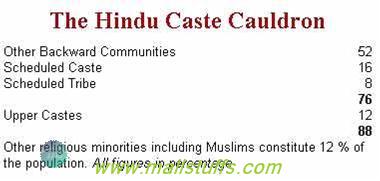
India population caste-wise
n addition to the central government policy, individuals state governments have their own positive discrimination policy. Different states implements positive discrimination for different communities in diffrent proportions as per their population in that state. Each state governments submit their lists of communities eligible for positive discrimination. Very often, a particular community is entitled for positive discrimination in a specific state but not in another indian state.
These positive discrimination policies are creating new tensions in modern india since the high caste communities feel discriminated because of the reserve quota for the Backward Classes. There have been a growing case of large number of high caste participants competing for a few places reserved for them. While the Backward Classes participants do not have any competition at all. Many times to fill the quota, lower caste candidates are selcted even when they are not suitable whereas sometimes reserved positions remains vacant due to very few candidates from the lower classes.
Within the backward classes also, sometime issues happens because of the priority defined for backward classes. In case of vacant seats, scheduled castes candidate is preferred over a Scheduled Tribes candidate who is preferred over a other Backward Class candidate. Since only 27% seats are reserved for Other Backward Classes compared to 50% of India's population, other Backward Classes demanding for higher priorities and higher quotas for positive discrimination.
Additonally, many higher class commmunites demands themselves to be added in backward classes.
Conclusion:
This shows that caste system was, is and will be an evil to human society. Every step to eradicate and address caste system will lead to discrimination between people of different sects or groups as long as it exists. But today, caste system is more an effective tool for vote bank politics, than a major social issue.
Note: Images used on this website
are either a production of Bhaktivedanta Book Trust(https://www.krishna.com), Iskcon
Foundation or were found in google search under "Free to use and share". If any
of the images presented here violates copyright issues or infringes anyone copyright
or are not under "Fair use", then please bring it to our notice. Read
Disclaimer for more.
Share this to your friends. One of your friend is
waiting for your share.
Related Articles
Why mahashivratri is celebrated
Ill effects of caste system
Why cow is sacred to hindus
Experience at hajiali dargah
Why we cannot see god
Common questions and myths of caste system
Why hinduism is the most tolerant religion
Bhagavad gita quote against caste system
Bhagavad Gita Poetic Translation-Text 1
Why hindu intolerance is rising in india
Post Comment